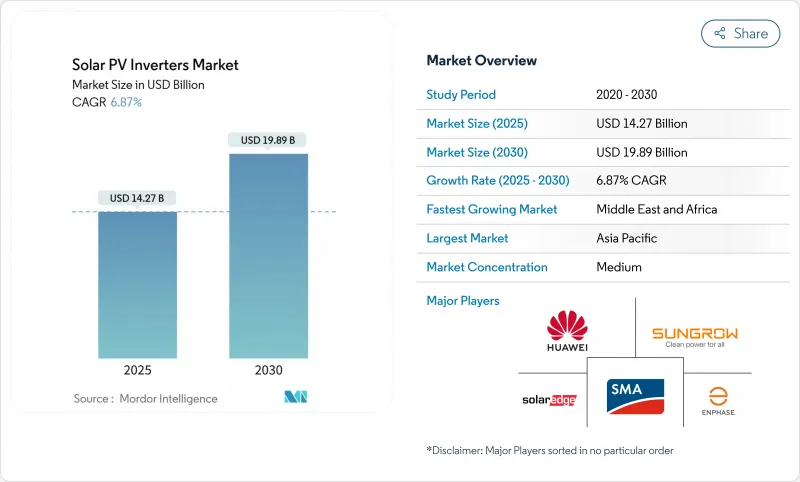
|
市場調査レポート
商品コード
1851529
太陽光発電インバーター:市場シェア分析、産業動向、統計、成長予測(2025年~2030年)Solar PV Inverters - Market Share Analysis, Industry Trends & Statistics, Growth Forecasts (2025 - 2030) |
||||||
カスタマイズ可能
適宜更新あり
|
|||||||
| 太陽光発電インバーター:市場シェア分析、産業動向、統計、成長予測(2025年~2030年) |
|
出版日: 2025年07月07日
発行: Mordor Intelligence
ページ情報: 英文 220 Pages
納期: 2~3営業日
|
概要
太陽光発電インバーター市場規模は2025年に142億7,000万米ドルと推定・予測され、予測期間(2025-2030年)のCAGRは6.87%で、2030年には198億9,000万米ドルに達すると予測されます。

市場の拡大は、単純なDCからACへの変換から、電力品質を保護し、所有者の新たな収益源を解き放つスマートなグリッド形成ソリューションへの移行に支えられています。アジア太平洋が世界の需要を支えているが、大規模な公益事業プロジェクトとグリッド近代化の課題が交錯している中東が、現在最も急成長している地域です。日本の堅調な買い替えサイクル、インドの屋上設置義務、米国と欧州の高電圧設計が、当面のユニット数量を増加させる一方、中国におけるSiC/IGBTの持続的な不足と抑制の高まりが、拡大ペースを弱めています。こうした逆風にもかかわらず、高度なグリッドサポート機能に対する割高な価格設定により、太陽光発電用インバーター市場の総収益は上昇を続けています。
世界の太陽光発電インバーター市場の動向と洞察
公益事業規模プロジェクトにおける高電圧1,500Vストリングインバーターの急速な採用(米国、スペイン)
ユーティリティ・デベロッパーは、バランス・オブ・システム・コストを下げ、電力密度を高めるために、1,500 VのDCアーキテクチャを指定することが増えており、2,000 VのDCアーキテクチャも試験的に導入しています。GE Vernovaの2,000 Vプラットフォームは、平準化エネルギー・コストを削減する30%の出力向上を示しています。この電圧の移行は、特に土地とグリッドのヘッドルームによってより大きなブロックサイズを可能にする場合、新築サイトでは1,000 Vアレイを経済的に陳腐化させ、改修プロジェクトに拍車をかける。半導体需要の高まりは、SiCデバイスの供給を逼迫させ、大手ブランドにおける熱設計の専門知識の戦略的重要性を高めています。
インドの商業ビルにおける屋上太陽光発電の義務化が100kW未満のインバータ需要を押し上げる
インドの政策では、新規および既存の商業施設に屋上アレイの設置が義務付けられており、100kW未満のインバータに対する持続的なニーズが高まっています。2024年度には4GWという記録的な増設が予定されており、機会の大きさを物語っています。国内メーカーは、2026年までに110GWのセルとモジュールを建設する計画に盛り込まれた輸入代替目標から恩恵を受け、国内のバリューチェーンを強化しています。</p><p></p><h4>大電流SiC/IGBTパワーモジュールの持続的な不足と価格変動</h4><p>SiCウエハーの供給不足は、高効率インバーターを制約し続け、材料費を増大させています。ウエハーの財政難はリスク認知を高めていますが、インフィニオンはコスト効率の高い200mm SiCウエハーに切り替えることで、2026年以降の救済を示唆しています。</p><h3><u>セグメント分析</u></h3><p>2024年にはセントラルユニットが55%の収益リードを維持しましたが、モジュールレベルのエレクトロニクスがアーリーアダプターのニッチを超えていくにつれて、マイクロインバーターはCAGR 8.1%で成長すると予測されています。Enphaseは2025年に650万台以上の国内向けマイクロインバータを出荷し、米国ローカライゼーション基準を満たし、同分野の商業規模を実証しました。太陽光発電インバーター市場は、ASIC設計、無線データ、熱工学を小型のフットプリントに統合した企業に報酬を与えています。中央アーキテクチャは現在、中国での電力抑制による需要の横ばいに直面しているが、その他の地域では、特に工場レベルの制御と競争力のある設備投資が最優先課題である電力事業プロジェクトに根を下ろしています。
競合の激しさはマイクロエレクトロニクスで顕著で、ハードウェアのコストよりも、ファームウェアの高度化や安全認証が障壁となっています。その結果、低価格の参入企業は、急速シャットダウンやバッテリー・インターフェイス・モードなどの急速な機能展開に追いつくのに苦労しています。堅調な数量成長にもかかわらず、マイクロインバータが今後10年以内にストリングプラットフォームを駆逐することはないと思われます。
2024年の出荷台数の63%は電力会社が占めているが、これは長期PPAで固定された大規模なプロジェクトパイプラインを反映しています。それでも、グリッドサービスやネット課金の枠組みが家庭の経済性を向上させるため、住宅用システムは年率7.6%で拡大すると思われます。インドのPradhan Mantri Surya Gharプログラムでは、2027年3月までに30GWの屋上アレイを設置することを目標としており、オーストラリアではバッテリーのアドオンの動向によって設置率が上昇しています。商業用屋上はインドの屋上義務化の波に乗りつつあるが、他地域では投資回収期間を引き延ばすような慎重な融資条件に直面しています。
プロシューマーは双方向機能とアイランドモードの回復力をますます重視するようになっており、インバーターOEMはバッテリー制御ロジックの統合を促しています。その結果、太陽光発電インバーター市場の総売上高が伸び悩んでいるマクロ的な設置台数の伸びを補う形で、ASPが上昇しています。一方、ユーティリティ事業者は1,500Vと2,000Vのプラットフォームに注力し、より厳格なグリッドコードに準拠するためにSTATCOMのような機能を搭載しています。
太陽光発電インバータ市場レポートは、インバータタイプ(中インバータ、ストリングインバータ、マイクロインバータ、ハイブリッド/バッテリーレディインバータ)、位相(単相、三相)、接続タイプ(オングリッド、オフグリッド)、用途(住宅、商業・産業、ユーティリティスケール)、地域(北米、欧州、アジア太平洋、南米、中東アフリカ)で分類しています。
地域分析
アジア太平洋地域は、中国の垂直統合型サプライチェーンとインドの政策主導型屋上緑化推進に支えられ、2024年出荷量の55%を占めました。中国の新しい市場ベースの関税制度は、グリーンフィールドの設置を減速させるかもしれないが、出荷量の回復力は、ストレージと高電圧ストリングを組み込んだ改修に起因します。2026年までに110GWに達するというインドの製造能力は国内調達のループを強化し、国内の太陽光発電インバーター市場を輸入の変動から守るが、規制の執行における地域格差が当面の利益を抑制します。
中東は2030年までのCAGRが最速の9.4%を記録し、ギガワット規模のプロジェクトを経済多様化の青写真に合致させています。厳しい砂漠の条件が高熱設計の需要を押し上げ、密閉型キュービクル・ソリューションに特化した欧州のOEMにニッチを開きます。サウジアラビアとアラブ首長国連邦の送電網強化の取り組みにより、低電圧ライドスルーと無効電力管理の仕様が引き上げられ、ベンダーはより厳しい公益事業ベンチマークに照らして製品を認証するよう迫られています。
北米と欧州は、買い替えと改修のサイクルが増加需要を支配する成熟した設置基盤の中で運営されています。米国ではインフレ抑制法の国内電力量控除により、現地生産が加速しており、テキサス州、サウスカロライナ州、アリゾナ州の施設は、2026年までに年間生産量が30GWを大きく上回ることを目標としています。欧州では、ドイツやスペインなどの市場で再生可能エネルギーの普及率が50%を超え、グリッド形成機能の価値が高まり、新規建設量が頭打ちになってもベンダーはより高いASPを通すことができます。
その他の特典:
- エクセル形式の市場予測(ME)シート
- 3ヶ月のアナリストサポート
よくあるご質問
目次
第1章 イントロダクション
- 調査の前提条件と市場の定義
- 調査範囲
第2章 調査手法
第3章 エグゼクティブサマリー
第4章 市場情勢
- 市場概要
- 市場促進要因
- ユーティリティ・スケール・プロジェクトにおける高電圧1 500Vストリング・インバータの急速な採用(米国、スペイン)
- インドの商業ビルにおける屋上ソーラー義務化が100kWインバーター需要を押し上げる
- 2012年から2016年の日本のFITブームで設置されたインバーターの積極的な交換サイクル
- 欧州のASPを支える高度なグリッドサポート機能の統合
- 太陽光発電と蓄電のハイブリッドソリューションの成長がオーストラリアの双方向インバーターを牽引
- ブラジルで中央インバータの国内生産を奨励する現地化インセンティブ
- 市場抑制要因
- 大電流SiC/IGBTパワーモジュールの持続的不足と価格変動
- 中国北西部における電力抑制の高まりが中央インバータの受注を鈍らせる
- 細分化された米国の相互接続規定が認証コストを押し上げる
- 屋上直流回路の火災安全性への懸念がドイツのマイクロインバータ普及を遅らせる
- サプライチェーン分析
- 規制の見通し
- テクノロジーの展望
- ポーターのファイブフォース
- 供給企業の交渉力
- 消費者の交渉力
- 新規参入業者の脅威
- 代替品の脅威
- 競争企業間の敵対関係
第5章 市場規模と成長予測
- インバータタイプ別
- 中央インバータ
- ストリング・インバータ
- マイクロインバータ
- ハイブリッド/バッテリー対応インバーター
- フェーズ別
- 単相
- 三相
- 接続タイプ別
- オングリッド
- オフグリッド
- 用途別
- 住宅用
- 商業・産業用
- ユーティリティ・スケール
- 地域別
- 北米
- 米国
- カナダ
- メキシコ
- 欧州
- 英国
- ドイツ
- フランス
- スペイン
- 北欧諸国
- ロシア
- その他欧州地域
- アジア太平洋地域
- 中国
- インド
- 日本
- 韓国
- マレーシア
- タイ
- インドネシア
- ベトナム
- オーストラリア
- その他アジア太平洋地域
- 南米
- ブラジル
- アルゼンチン
- コロンビア
- その他南米
- 中東・アフリカ
- アラブ首長国連邦
- サウジアラビア
- 南アフリカ
- エジプト
- その他中東・アフリカ地域
- 北米
第6章 競合情勢
- 市場集中度
- 戦略的な動き(M&A、パートナーシップ、PPA)
- 市場シェア分析(主要企業の市場ランク/シェア)
- 企業プロファイル
- Huawei Technologies Co., Ltd.
- Sungrow Power Supply Co., Ltd.
- SMA Solar Technology AG
- SolarEdge Technologies Inc.
- Enphase Energy Inc.
- FIMER SpA
- Delta Electronics, Inc.
- Growatt New Energy Technology Co., Ltd.
- Ginlong(Solis)Technologies
- TMEIC Corporation
- Mitsubishi Electric Corporation
- Schneider Electric SE
- Siemens AG
- Eaton Corporation plc
- Hitachi Energy Ltd.
- Omron Corporation
- Power Electronics Espana S.L.
- Chint Power Systems Co., Ltd.
- GoodWe Technologies Co., Ltd.
- GE Vernova
- Canadian Solar Inc.(CSI Solar)
- Toshiba Mitsubishi-Electric Industrial Systems Corp.(TMEIC)
- Kepco KPS(South Korea)

